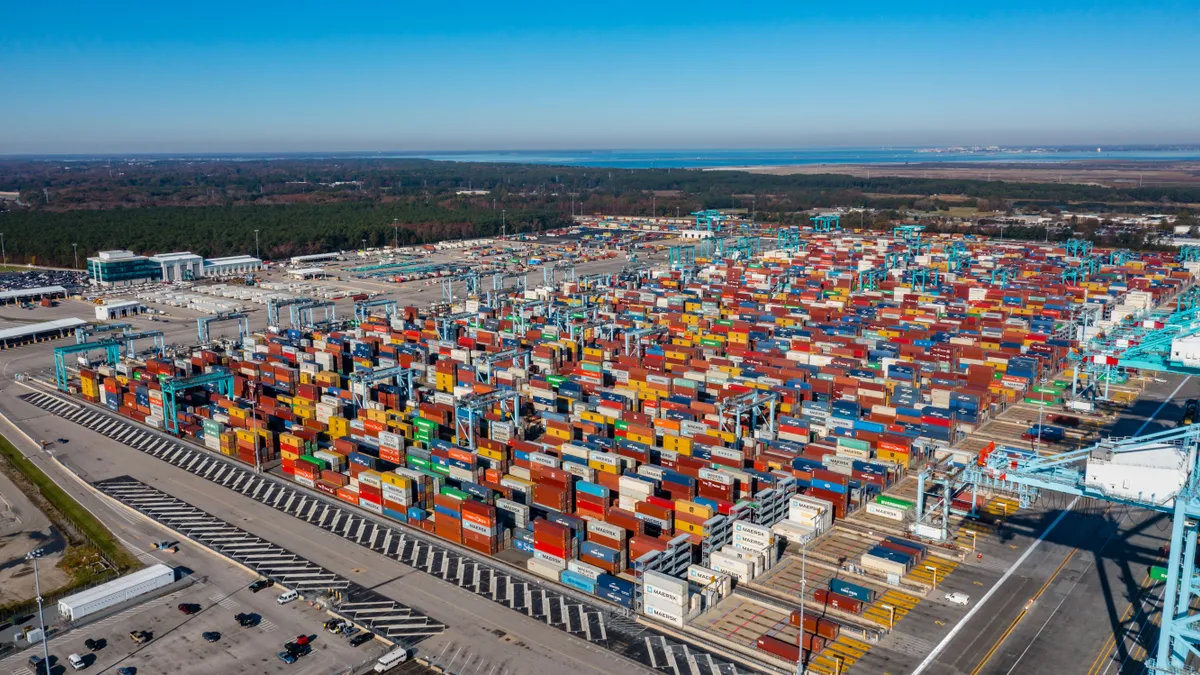Dive Brief:
- Import cargo volume will rise through this summer at major U.S. ports. But cargo volumes will likely stay below record-setting levels seen during the pandemic, according to a Global Port Tracker report released Friday by the National Retail Federation and Hackett Associates.
- America’s largest ports handled 1.68 million Twenty-foot Equivalent Units, or 20-foot containers, in March, down about 28% year over year. The report projects that year-over-year cargo volume by TEU will be down 18% in April, 20% in May, and nearly 12% in June. By July and August, the report forecasts volume will drop nearly 4% and 6%, respectively.
- In February, imports dropped to 1.55 million 20-foot units, which was down over 25% year over year. The NRF and Hackett said the large year-over-year declines are skewed by unusually high volumes last year. Imports averaged 1.8 million TEUs per month pre-pandemic in 2019, versus an all-time monthly record of 2.4 million units in May 2022.
Dive Insight:
While February is usually the slowest month of the year for imports, the number was the lowest since May 2020 when many factories in Asia, along with many U.S.-based retailers, were closed due to the pandemic.
By Q2 of 2022, retail inventories had risen 31% year over year. The retail inventory glut remained an ongoing issue last year. Retailers increased promotional activity to try and ease the backlog.
From a retail supply chain perspective, “last spring and summer were the busiest ever as consumers spent freely and retailers brought in merchandise to meet demand,” said Jonathan Gold, the NRF’s vice president for supply chain and customs policy.
While a repeat of that this year is unlikely, Gold said the projected volume is more in line with what would have been considered normal pre-pandemic. Labor negotiations at West Coast ports may also play a role in how the rest of this year’s shipping season will play out.
That’s because a contract between the International Longshore and Warehouse Union and the Pacific Maritime Association expired last July. The NRF’s announcement notes that while workers are still on the job, “many shippers have shifted cargo elsewhere to avoid any potential disruption.” The NRF in March sent a letter to President Joe Biden signed by nearly 240 national, state and local trade associations. The letter urges the Biden administration to get involved to avoid disruptions to port operations and cargo movement.
Compared to last year, the flow of import containers on the West Coast continues to decline, said Ben Hackett, founder of Hackett Associates. Hackett said demand is also down as more carriers drop service to Los Angeles-area ports. Carriers are now choosing to stretch some voyages to other ports to help absorb excess capacity.
According to the report, the first half of 2023 is forecast at 10.8 million 20-foot units. That’s down 20.2% from the first half of 2022. Imports for all of 2022 totaled 25.5 million 20-foot units, down 1.2% from the annual record of 25.8 million TEU in 2021.
Hackett Associates produces the Global Port Tracker for the NRF. The report provides data about ports in California, New York, New Jersey, Virginia, South Carolina, Georgia, Florida, Texas and Washington state.













